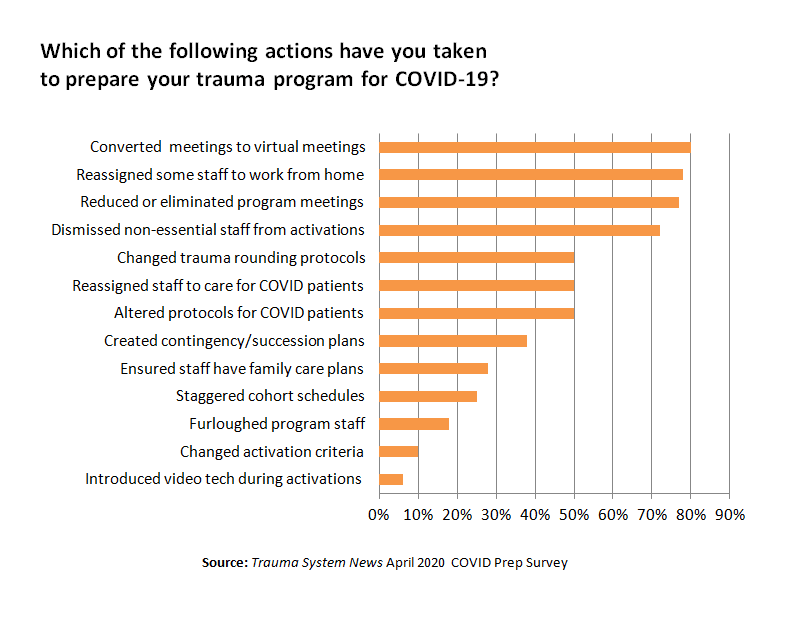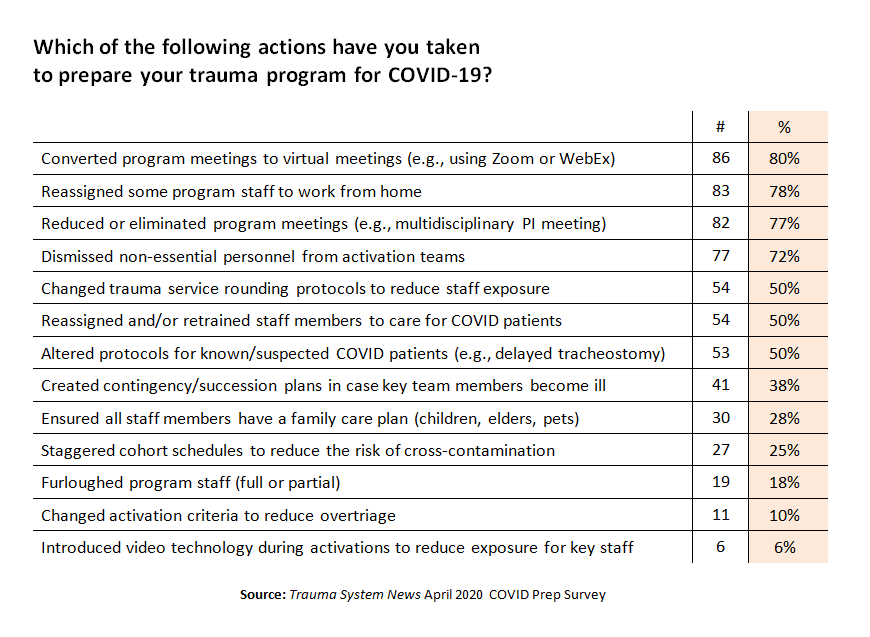COVID-19 is having a complex impact on trauma centers. While injury rates are down worldwide, hospitals are still receiving injured patients. And in many ways the pandemic has made trauma care more complicated than ever.
What have trauma programs done to maintain patient access and standards of care during the coronavirus pandemic? To find out, Trauma System News recently surveyed trauma program leaders on how they prepared for COVID-19.
The survey results show that trauma programs have taken multiple steps to protect the safety of team members. Many programs have reorganized team structures and reworked care protocols. Trauma leaders are also working closely with partners across the spectrum to maintain trauma system capacity.
Survey results: Top actions to prepare trauma for COVID-19
The COVID prep survey was emailed to approximately 750 trauma program managers, trauma medical directors, trauma surgeons and trauma coordinators on April 8 and 9, 2020, and responses were collected through April 10.
Responses were received from 107 individuals, for an overall response rate of 14%. Nearly three-quarters of respondents (72%) were trauma program managers, and 15% were trauma medical directors. All responses were anonymous, so the results may reflect duplicate feedback from some trauma programs.
In the first part of the survey, trauma program leaders were asked to review a list of COVID-19 prep activities and check the ones their program had implemented.
The survey results show that nearly all trauma programs took action to support social distancing. Approximately four-fifths of programs reduced, eliminated or virtualized program meetings, and reassigned some staff to work from home.
In addition, 72% of programs dismissed non-essential personnel from activation teams, as recommended by the ACS Committee on Trauma (COT) in its March 2020 guidance: Maintaining Trauma Center Access and Care during the COVID-19 Pandemic.

One of the less common changes was also a COT recommendation — staggering staff cohorts. In this survey, only 25% of respondents reported staggering cohort schedules to reduce the risk of cross-contamination.
In the second part of the survey, trauma program leaders were asked to describe one or two of the most important actions their program has taken to prepare for COVID-19.
Out of the 107 respondents, 86 individuals provided detailed comments. Their responses (edited lightly for clarity) are summarized below.
Reorganizing teams and schedules to reduce cross-contamination
A quarter of respondents said their program has divided trauma staff into cohorts and staggered cohort schedules to reduce the risk of cross-contamination and protect key team members.
One trauma program manager explained: “We have developed a strict process for limiting trauma surgeons’ exposure — they are a small group of essential staff who, if they go down, we don’t have backup for.”
Respondents described several different approaches to staggering schedules:
- “The trauma surgeons work a schedule of only three in-house on any given week,” wrote one TPM. “They cover each other’s patients and rounding, and the NP rounds separately from them to decrease exposure.”
- One trauma medical director reported a week on/week off rotation for all trauma surgeons.
- A different TMD described a three-cohort schedule: “We’ve developed 3 ‘teams’ for our surgery and trauma coverage: 7 days on and 14 days ‘off.’ This limits exposure and attempts a modified ‘self-quarantine’ process in the effort to keep a strong reserve.”
- Another respondent reported that trauma surgeons are now on “perpetual weekend call.”
Several trauma program managers reported that a staggered approach has also been applied to program staff such as coordinators.
Working with EMS to screen patients before arrival
A handful of respondents reported collaborating with EMS agencies to screen trauma patients for COVID-19 in the field.

According to one trauma program coordinator, “Our pre-hospital providers were very proactive with implementing a screening process for all patients — including trauma activations — and communicating this information well in advance of arrival to our ED whenever possible.”
Pre-arrival screening processes include screening questions for patients as well as clinical screens for fever and oxygen saturation.
Early notification enables the trauma team to take special precautions. According to one trauma program manager, “EMS notifies the ED of potential COVID-19 patients by phone instead of the HEAR radio system so that staff can clear hallways, close doors, and direct intake to specific area.”
Only 10% of respondents said their center has changed trauma activation criteria to reduce overtriage. Three TPMs noted that their teams shifted from a two-tier activation plan to a single-tier model.
One program manager explained: “We’ve suspended our two-tier trauma activation system and transitioned to a single-tier system based solely on physiological indicators plus one MOI — penetrating trauma.”
Changing activation team makeup to reduce staff exposure
Nearly three-quarters (72%) of respondents noted that non-essential personnel have been removed from trauma activation teams. Several noted that this change not only reduces team exposure but also helps preserve PPE.
Respondents described a variety of “lean” team structures:
- “Early in the COVID crisis, responders to an activation were limited to the ED and Trauma Attending, Consult and 2 RNs — no one beyond that.”
- “This initial assessment is completed by essential personnel only — the MD team lead, a bedside RN, and an ED MD if airway concern is present.”
- “We have implemented nurse X2 dedicated to trauma whenever possible.”
- “We are a pediatric trauma center, so we include non-medical staff in typical Level II activations — Child Life to support the child, Social Work to support the parent. Those roles have been removed from the response.”
Several respondents noted that part of the activation team waits outside the trauma bay until needed. One trauma program manager described careful social distancing: “Everyone else [stands]on a taped x outside the trauma bay ‘on call’ spaced 6 feet apart.”
Some respondents commented that team size limitations apply specifically to high-risk procedures such as intubations and extubations. One trauma coordinator noted that these procedures are now performed by only the most experienced team members.
One trauma program manager reported that the ED physician has been removed from the trauma activation team. This change has freed up that specialist to care for COVID-19 patients and has also reduced the risk of cross-contamination.
However, another TPM reported that the ED physician has been put in charge of activation team staffing: “The biggest change is that of giving the ED physician the authority to coordinate the members of the team and decide who should be allowed into the trauma bay.”
Adopting enhanced PPE
The majority of commenters described enhanced protocols for personal protective equipment (PPE). Several reported that all trauma patients are now considered to be infected with COVID-19 until proven otherwise.
Several respondents specified that staff wear N95 masks and face shields during all trauma activations. Respondents also noted that extra precautions are in place for procedures such as intubation, chest tube placement and needle decompression. According to one TPM, all team members have been “trained and outfitted for aerosolizing procedures with PAPR.”
Respondents also noted an emphasis on PPE education and conservation. One hospital now has a dedicated coronavirus nurse. “The COVID RN is available 24 hours a day, 7 days a week, to answer staff questions about testing, PPE, etc. She is separate from our infectious disease RN. She rounds on the floors and ED to support those working with the patients.”
A few respondents commented on screening protocols for team members. Two trauma program managers reported that all employees are screened for COVID-19 every day.
Segregating care areas to reduce risk
Several respondents described efforts to segregate patients and prevent cross-contamination.
One trauma program manager noted that while several ED rooms have been designated for COVID-19 patients, the trauma room has been reserved for trauma. According to another TPM, the hospital has “added a protective barrier between shared trauma bays.”
Several trauma program managers reported that trauma bays and resuscitation rooms have been converted to negative pressure rooms.
One trauma program manager noted that all trauma patients are triaged in the hospital’s negative-pressure decontamination room in case intubation is needed. “Intubations are completed in decon, and then the patient is moved to the trauma room.”
Commenting on the survey results, Marco Bonta, MD, MBA, FACS, trauma medical director at Riverside Methodist Hospital in Columbus, Ohio, noted the value of negative air pressure in the trauma bay:
“For our hospital, the ED doctors needed/wanted another ‘intubating location’ for COVID-19 patients, because it is an aerosolizing procedure, and because there was only one other negative room in the department. Most trauma bays (like most operating rooms) are positive airflow because we don’t want microorganisms coming into the rooms where there are open wounds. I agreed to make our two trauma bays negative airflow because it’s probably of greater overall value to have another couple of intubating locations for COVID than the putative benefit of positive airflow for trauma.”
Two respondents reported the use of designated zones within trauma areas. In one hospital, PPE is now allocated for use in “red, yellow and green zones.” Another hospital has “designated a HOT Zone nurse and a Warm Zone nurse in the trauma room to avoid cross-contamination.”
Zoning is also being applied to supplies. One trauma program manager noted that mobile trauma carts are now kept outside the trauma bay. “This allows the room to be fully cleaned if a PUI comes in as a trauma, and it also allows usage of other rooms if the trauma bay needs terminal cleaning.”
Another TPM reported the creation of “special intubation kits, crash cart drugs, Rapid Sequence Intubation (RSI) drugs just for COVID patients.”
Altering trauma activation protocols
Several respondents described changes to the initial assessment process for trauma patients. One trauma medical director outlined a staged approach:
- “The trauma patient is first evaluated by an anesthetist and a nurse (both in PPE) who ask screening questions, measure the patient’s temperature and perform a lung ultrasound.”
- “If the first examination is negative for suspected COVID, the entire team evaluates the patient wearing PPE.”
- “If the first exam is positive for suspected COVID, the patient will be evaluated only by a surgeon or orthopedic surgeon based on his lesions.”
- If imaging is required, the patient will go to a designated scan unit for COVID-19 patients.
- “At the same time, we send blood exams and PCR swabs. The patient will stay isolated up to the final results of the swab and blood exam.”
Several respondents reported developing special protocols for high-risk procedures. For example, a trauma medical director described this staffing protocol for intubation of suspected COVID-19 patients:
“We will have a two-person intubation team (consisting of an MD and an RT or a CRNA and an RT), with the RN outside of the room preparing medications and handing them off to the MD who will administer.”
One trauma coordinator reported that intubations are performed in either a negative pressure room or utilizing an intubation box.
According to a TPM, trauma staff at one hospital have collaborated with ED, ICU and critical care providers to create a COVID Response Team:
“This team also has an Airway Response Team component that utilizes specialized procedures/protocols when performing intubations or other invasive procedures that could potentially expose patients to airborne contamination,” the TPM wrote. “The key is to work collaboratively and utilize open communication in an effort to prevent unnecessary exposure for our healthcare teams.”
Changing trauma rounding protocols
One-half (50%) of respondents reported altering trauma service rounding protocols to reduce staff exposure.
One trauma program manager described changes to team makeup and timing: “As COVID took over the facility, rounding was limited to the trauma chief, a consult, and the care manager. The time was also moved to an hour earlier or later than the shift change in order to limit the number of staff in the hall of the unit.”
Another TPM described a change of location: “Daily rounds have been moved out of critical care to a non-clinical area for daily clinical care/PI review.”
One trauma program is attempting to expedite patient discharge. According to the trauma program manager, “Trauma bed availability has been limited to 10, with an effort to treat and release.”
Retraining and reassigning trauma staff
One-half (50%) of respondents reported that trauma program staff have been reassigned and/or retrained to support care for COVID-19 patients. Several noted that these redeployments have been made possible by the recent drop in trauma and elective surgery volumes.
- According to one trauma medical director, the program has “eliminated plans to continue emergent general surgery, redeploying critical care surgeons to care for critically ill patients.”
- “We are redistributing our NP/PA team resources to critical care COVID teams,” explained one TPM. “They and other hospital APPs are under the leadership of the Trauma Lead APP.”
- Another TPM is now leading a proning team in the hospital’s medical-surgical units.
A few respondents noted that non-trauma providers have been trained to cover for trauma specialists. According to a trauma surgeon, one hospital has trained general surgeons to handle trauma. In another hospital, ICU and OR staff have been cross-trained to assist in the ED as needed.
A TMD explained: “We have maintained frontline staffing levels and the standard of care to ensure trauma patients do not unnecessarily add to the burden of care in the ICU and other hospital services.”
Several respondents described hospital-wide education efforts to bring staff up to speed on COVID-19 care. A trauma medical director at a critical access hospital explained:
“Given that we have a high number of our staff who float to other departments, our other focus has been on hands-on ventilator management training for RNs in all departments, manual pronation techniques for patients, and increasing RN skills on blood draw so as to decrease ancillary staff exposure to the patient.”
In addition, a trauma program manager reported that a hospital is “beginning to implement a ‘team nursing’ model in the ICU since we are redeploying non-ICU nurses to help out in that unit.”
Changing staff processes to promote social distancing
Respondents reported the widespread reduction or elimination of meetings (77%), use of virtual meeting platforms (80%) and reassignment of staff to work from home (78%). Only 18% of respondents said trauma program staff have been subject to full or partial furlough.
Here are a few representative comments:
- “All non-essential personnel on the trauma team (PI coordinator, trauma registrars) are working remotely. This is not new except that teleworking is now 100% vs. pre-COVID of approximately 60% telework.”
- “The registrars were sent home to work remotely. The lead meets with the TPD one day a week to review the week and plan for the coming weeks. We originally attempted to Webex our systems meeting, but as COVID cases increased we cancelled all meetings going forward.”
- “The majority of program staff who are non-RNs are either work from home or furloughed. RNs could be redeployed when the need arises.”
Some trauma program managers noted that PI efforts have been temporarily reduced or suspended. Other TPMs, however, reported that PI staff are working remotely and the program continues to track PI issues.
Changing the flow of patients through regional trauma systems
According to survey respondents, trauma program leaders are working at the regional level to prepare for COVID-19.
Several respondents described system-level efforts to reduce transfers from referring hospitals. A trauma program manager in Wisconsin explained regional planning efforts: “The WI TQIP Collaborative worked on a guideline that would assist the Level 3 and 4 trauma centers to potentially admit/keep minimally injured trauma patients at their facility rather than transfer. All members of the WI TQIP Collaborative agreed to this guideline. … The key point stressed at all levels is communication between all the centers and within their respective regions.”
Several respondents reported a growing role for telehealth technology. One TPM explained, “We are working with outside hospitals to do more thorough consultations via image-sharing and telemedicine to decrease the amount of transferred patients.”
In addition, two respondents noted plans to utilize pediatric trauma center capacity to decompress adult trauma centers. One program manager at a Level II pediatric trauma center described a three-tier plan:
“Our region defines pediatric trauma as less than 15years. For our first tier, we will expand to 18 years if needed. The second tier would expand to age 25 years if needed. At the third tier, we will expand to age 30 if needed. We have had conversations in our RAC and with the adult centers in our region regarding the need for emergency credentialing for adult ortho and vascular surgeons if we have to activate the tiers.”
Do trauma leaders play a special role in the COVID-19 pandemic?
One respondent noted that the need to prepare the trauma program for COVID-19 is getting little attention from hospital leaders:
“Administration is spun out chasing their tails — trauma is not even close to making their list. The things I answered ‘yes’ to are things the facility has at least somewhat addressed.”
However, another TPM reported that trauma professionals are taking the lead on pandemic response:
“We have approached COVID much like trauma. We developed a database to track and trend patients, outcomes and interventions. We have used this information to support providers during multi-disciplinary rounds to identify clinical pathways and best practice interventions. The information has allowed us to effectively manage patient flow of positive and PUI patients between units. Additionally, it has enabled us to assess PPE needs per unit and allocate resources appropriately.”
At this hospital, the unique strengths of the trauma program have benefited both staff and administration:
“Using the abilities of the trauma team to abstract data, identify process improvements and become a resource expert has increased morale in nursing staff, provided real time patient flow to senior leaders and practice guidance to physicians.”
Robert Fojut is the editor of Trauma System News. Special thanks to Marco Bonta, MD, MBA, FACS for consulting on survey design and reviewing the survey results.


